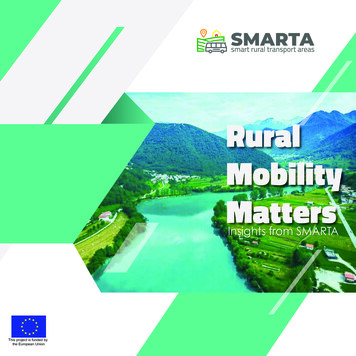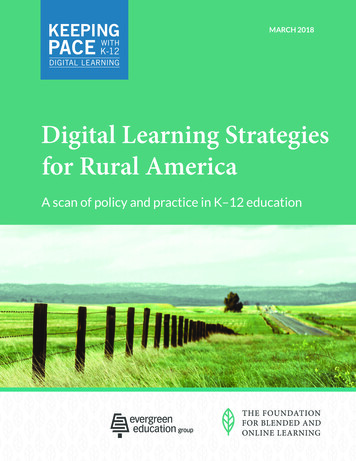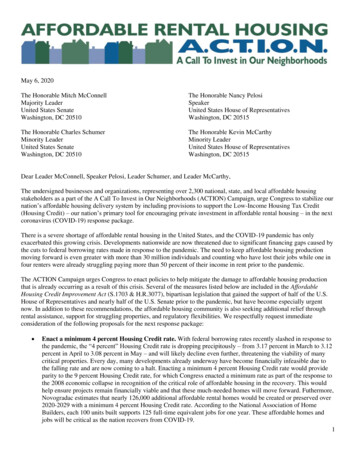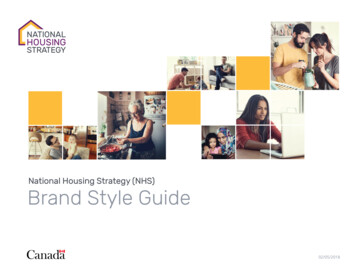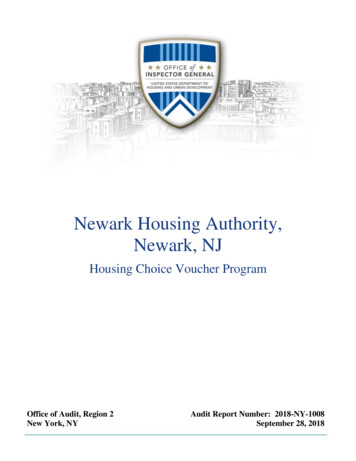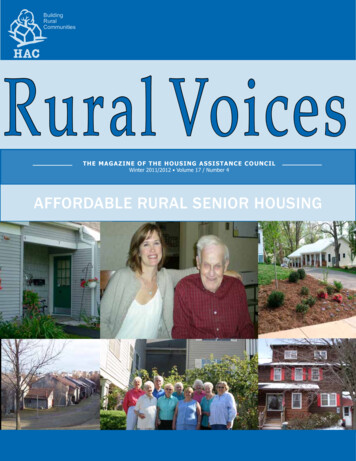
Transcription
BuildingRuralCommunitiesRural VoicesTHE MAGAZINE OF THE HOUSING ASSISTANCE COUNCILWinter 2011/2012 Volume 17 / Number 4Affordable Rural Senior Housing
message to our readersContentsDear Friends,Over the next several decades, the elderly population will more than doublein size. As the elderly population grows, the need for affordable housing forlow-income seniors will only increase. Low-income seniors face poverty,housing problems and a lack of affordable service options. These issues areoften compounded in rural areas that lack affordable options that take intoconsideration the special needs of this population. In this issue of Rural Voices,the Housing Assistance Council (HAC) is pleased to highlight organizationsacross the country that have seen success in providing and advocating for safeand secure housing for rural seniors.Articles from nonprofits across the country demonstrate the work being doneto provide not only access to safe, secure housing for low-income seniors, butalso improved quality of life and increased longevity. Policy perspectives fromAARP and LeadingAge provide insight into the importance of advocatingfor affordable senior housing. Both organizations are critical resources andproponents of seniors and continue to fight to ensure this population is notforgotten.Articles by Clark Senior Housing in Iowa and Catholic Charities of Yakimain Washington highlight the importance of the United States Departmentof Agriculture’s Section 515 and the Department of Housing and UrbanDevelopment’s 202 programs for rural communities. An interview withCarolyn Branton from HAC’s Southeast Regional Office further stressesthe amazing work that organizations can accomplish with federal funding.The Self-Help Home Improvement Project (SHHIP) in Redding, California,provides a unique perspective on the importance of self-help housingprograms. Articles by the National Community Reinvestment Coalition inWashington, D.C., and Cathedral Square in Burlington, Vermont, discussreverse mortgages and assisted and supportive rental housing for seniors.These articles demonstrate the hard work being done nationawide to ensurethe housing needs of rural seniors are being met. These organizations arefurther evidence of the success and importance of federal senior housingprograms and must act as a reminder that seniors cannot be forgotten,especially in times of economic hardship.3 HAC FACTS4 Views from WashingtonAffordable Housing and Services for Seniorsby Nancy Libson and Robyn Stone, LeadingAge6 AARP Foundation Launching Strategy to AddressHousing Needsby John Carpenter, AARP FoundationARTICLES8 Rehab - Renew: Housing Rehabilitation for SeniorsThe Self-Help Home Improvement Project (SHHIP) hasdeveloped several products and strategies to assist theirprimarily senior clientelle in rural California.10 Opportunities to Meet the Needs of Seniors in RuralAmericaCathedral Square Corporation (CSC), the largest provider ofaffordable senior housing in Vermont, shares its methods fordevelopment.12 USDA Rural Development and HAC Work Together toImprove Housing in Rural IowaUSDA Rural Development in Iowa details several examples ofHAC and USDA RD facilitating local development partnershipsand projects.14 Section 202: Interview with Carolyn BrantonCarolyn Branton, Director of HAC’s Southeast Regional Office,sits down for an interview to discuss the uses of and importanceof HUD’s Section 202 program.16 Senior Housing in Rural Washington.The story of Catholic Charities Housing Services’ senior housingdevelopment, Rose of Mary Terrace from conception in 2003 tocompletion in 2008.18 Reverse Mortgages After the RecessionLearn more about reverse mortgages as they apply to olderAmericans. What are the advantages, pitfalls and precautionsto be aware of when using these loan products.In community,Joe Debro, ChairTwila Martin Kekahbah, PresidentThis issue of Rural Voices was made possible withsupport from The Atlantic Philanthropies. Theissue is part of HAC’s Rural Senior HousingInitiative. Additional support was provided by theJohn D. and Catherine T. MacArthur Foundation.Moises Loza, Executive DirectorCover Photos (clockwise from left): Cathedral Square,Cathedral Square, AARP Foundation, Cathedral Square,Bainbridge Island Review
FactsNotes about some of the recent activities, loans, and publications of the Housing Assistance CouncilHAC Provides Funds for Self-Help HousingOn November 4 the HAC Loan Committee approved 9.21million in financing to support development of 626 self-helphomeownership units. The funding -- from HAC’s Self HelpHomeownership Opportunity Program (SHOP) and RuralHousing Loan Fund -- goes to 32 local nonprofit housingdevelopers in 15 states. The local groups use the funds forland and infrastructure costs of developing sweat-equity-builthomes for first-time, low-income homeowners. Funding isfor up to 15,000 per unit. Participating families put at least100 hours of sweat equity labor into their own and theirneighbors’ homes, with many contributing 1,000 hours ormore. The families move in with an average of about 25,000in equity in their homes. HAC’s SHOP program comesfrom an annual HUD competition, based on appropriationsfrom Congress. Since 1996 HAC has won 108 million inSHOP funds to support 8,490 self-help homes. More than7,600 homes are complete and occupied, with another 1,100underway. HAC has helped build substantially more SHOPunits than required by the HUD funding.HAC Receives Funding from Starbucks and OFNThe Housing Assistance Council (HAC) is one of 28 CDFIsto receive a grant from the Create Jobs for USA Fund, acollaboration between Starbucks and Opportunity FinanceNetwork (OFN). The money will help HAC create andsustain jobs in rural America as part of a national campaignto support small, community businesses.“By making a donation to the Create Jobs for USA Fund,Starbucks customers and concerned citizens can takemeaningful action to help create and sustain American jobs,”said Starbucks Chairman and CEO Howard Schulz. Donorswho contribute 5 or more will recieve a red, white and bluewristband with the message “Indivisible.” The wristbandsare individually handmade in the U.S.A. and all componentmaterials are manufactured by U.S. suppliers, so the effort isalso helping support American manufacturing jobs. For more information about HAC visit www.ruralhome.org.HAC Releases New Research ReportsHAC has completed the research and produced report on thefollowing topics: Rural Reentry: Housing Options and Obstacles for ExOffenders. details the regulations associated with housing formerlyincarcerated persons, provides resources available for rural communitiesmanaging these issues and supplies recommendations for practitionersand stakeholders. .“A strong rural America is vital to the success of theAmerican economy,” said Moises Loza, HAC ExecutiveDirector. “The Create Jobs for USA Fund provides people asimple and straightforward opportunity to invest in their owncommunities and help build a stronger rural America. Nonprofit Capacity in the Lower Mississippi Delta RegionHAC summarizes the results of a survey on organization capacitydistributed to 227 nonprofit housing organizations in the LMD. For more information about the Create Jobs for USAFund, visit www.CreateJobsforUSA.org.Call for Workshop Topics - 2012 National RuralHousing ConferenceSeason’s GreetingsThe 2012 National Rural Housing Conference will be heldin Washington, DC on December 6-8. HAC strives to keepthe Conference relevant and engaging. If you have an ideafor a workshop or general session topic you would like to seeaddressed, please contact Dan Stern at dan@ruralhome.orgor (202) 842-860 ext. 137.The Housing Assistance Council’sboard and staff wish you andyours hope, peace, and happinessthis holiday season and for yearsto come. Check back with www.ruralhome.org for updates onthe 2012 National Rural Housing Conference.Housing Assistance Council3Rural Voices Winter 2011/2012
View from WashingtonAffordable Housing and Services forSeniors:The Challenges in Rural AmericaBy Nancy Libson and Robyn StoneThe United States is experiencing unprecedented changesin its elderly population as it grows larger and older. Thenumber of seniors is expected to double by 2030, when onein five citizens will be over the age of 65. By 2050, one outof every four seniors will be over the age of 85. The trendsare the same in rural and urban America. Research showsa strong correlation between old age, chronic conditions,disability, and the use of long-term care services. Youngerpeople with disabilities are also living longer, adding tothe demand for services and supports. This convergenceof trends places an enormous strain on the United States’long-term care system, and Medicare and Medicaid costs areexpected to soar.Senior Housing NeedsIn order to address the growth in the senior population andthe soaring costs of health care in the Medicare and Medicaidprograms, LeadingAge (formerly AAHSA) advocates forpolicies and practices that link affordable unlicensed seniorhousing properties — such as Section 202, the low-incomehousing tax credit (LIHTC), or public housing communities— with health and supportive services as a cost-effectiveanswer for meeting the long-term care needs of lowerincome seniors. However, this approach poses challenges inrural areas. The demographics, availability of services, andhousing trends, such as fewer multifamily housing settingsin rural areas, may not lend themselves to the “traditional”affordable housing with services models that may be availablein metropolitan areas even though the senior populationspresent similar characteristics.Twenty-three percent of all households are located in ruralAmerica. Of those households, 23 percent, or six million,are headed by seniors. As a recent HAC fact sheet outlines,rural senior households overwhelmingly reside in theirown homes. According to HAC’s tabulation of the 2009American Housing Survey, 89 percent of nonmetro seniorsown their homes. That is an increase of 4 percent from the1999 American Housing Survey. Typically, those seniors arewomen living alone and living in poverty. Overall about 9.5million, or 9 percent, of nonmetro senior households live inpoverty. Although rural elderly persons are predominatelywhite, poverty among minority elders in rural areas, includingAfrican Americans, Native Americans, and Hispanics, is twoto three times higher.Housing Assistance CouncilLow- and moderate-income seniors are experiencingdeclining health and increasing frailty levels wherever theylive. It is only natural that seniors will have multiple chronichealth conditions as they age and need assistance with dailyliving activities. Without easy access to health and otherrelated supportive services, seniors often cycle in and out ofemergency rooms and hospitals, at high costs to Medicare.Some may transfer unnecessarily or prematurely to nursinghomes if they are available in the community with costs paidby Medicaid, because they need more care or oversight thanis available at home. In rural areas, seniors may be forced tomove to a more urban location because they cannot get theservices they need at home.4Rural Voices Winter 2011/2012
knows the residents of the housing site and the seniors inthe community, the SASH staff members form a team withthe existing long-term care network and include a designatednurse from the Visiting Nurse Association, a designatedcase manager from the AAA, a representative of theProgram of All- Inclusive Care for the Elderly (PACE), anda representative from the community mental health agency.The team meets twice a month to review the well-being ofMedicare-eligible SASH participants.The Challenges in Rural AmericaProviding appropriate health and other supportive servicesin rural areas to low- and moderate-income seniors willrequire creativity. The population density of multifamilyhousing sites, which are prevalent in urban and suburbansettings, is not available in rural America. Even where thereare multifamily settings, they are usually not of a scale ableto support an array of services on-site unless they serve theentire community. Most senior households reside in singlefamily homes that may not be in neighborhood or communalsettings; rather, they are scattered. Further transportation toand from health and other supportive services, such as mealprograms, community hospitals, senior centers, even doctors’offices and other primary care, is not readily available.Although this program is funded by Medicare, a similarapproach can be adapted using other funding, includingfoundations, Community Development Block Grant funding,or OAA case management funding, to provide supportiveand wellness services to seniors in rural areas. The criticalcomponents are the care coordinator and the wellnessnurse, who create partnerships with the available serviceproviders in the urban or rural community. In rural settings,the community hospital or a community nursing home maybecome a partner if there are no other partners.There are, however, opportunities in rural areas to linkhousing to community-based services. Area agencies on aging(AAA) that serve rural counties are one source of supportiveservices. Funded by the Older Americans Act (OAA), theAAAs may provide home-delivered meals, in-home care, casemanagement, and even transportation, the major barrier toaccessing health and other services in rural areas.As housing with services becomes the accepted practice forkeeping seniors at home wherever they reside, evidence thatthis practice will save money in the health-care system willbecome available over time. That is LeadingAge’s and itsCenter for Applied Research’s agenda for urban, suburban,and rural America.Innovative StrategiesTechnology offers other opportunities. One initiativethat a low-income senior housing property in New YorkCity is piloting is a virtual senior center concept in whichhomebound elderly residents participate in a local seniorcenter’s activities online. Telehealth also provides a rangeof opportunities to remotely link rural elders in a variety ofhousing settings with clinicians who can monitor vital signs,diagnose problems, and work with older adults to engage inbetter self-care management. Nancy Libson is the Director of Housing Policy forLeadingAge and Robyn Stone is the Senior Vice Presidentof Research for LeadingAge. For more information onLeadingAge and its programs, please visit www.leadingage.org.Vermont offers an example of a housing and servicesmodel that can work in rural areas if there is an affordablehousing community that can serve as the primary locationfor the program. The program, Support and Services atHome (SASH), designed by Cathedral Square Corporationin Burlington and to be implemented throughout Vermont,including its remote rural areas, is a demonstration programfunded by Medicare under the Centers for Medicare andMedicaid Services. SASH will provide supportive services toseniors (and persons with disabilities) in their homes. TheSASH program allows for an organized, person-centeredapproach to wellness in the housing community and in thesurrounding community. Organized around a care manager,the SASH coordinator, and a quarter-time wellness nurse whoHousing Assistance Council5Rural Voices Winter 2011/2012
View from WashingtonAARP Foundation launching strategy toaddress housing needsby John CarpenterOver 60 years ago, retired educator Dr. Ethel PercyAndrus paid a visit on a former colleague.HAC Deputy Executive Director Joe Belden. “Our approachhas been to first understand the problem and then to reachout to thought leaders from across the country to hear howthe Foundation can become a leading voice addressing thehousing challenges facing older Americans.”What she discovered on that visit set in motion the work theAARP Foundation is doing today in the field of affordablehousing. Andrus learned that her former coworker was livingin a converted chicken coop because it was the only homeshe could afford on her modest pension. Andrus’s shock atthe living conditions of her former colleague inspired herto found the National Retired Teachers Association andeventually the American Association of Retired Persons, nowknown as AARP.According to Vasallo, the housing worries facing olderAmericans are deepening.“The data reveals that conditions have deterioratedsignificantly for older households over the past ten years.Older homeowners and renters face greater affordabilityissues, and many low-income households face moreunsustainable housing costs since the housing crisis andrecession began in 2007.” Vasallo noted that these challengescut across urban and rural communities. “There is almost nocommunity in this country — big or small, urban or rural— with adequate affordable housing options for our agingpopulation.”“The founding of AARP was in many ways because of thelack of decent affordable housing for older Americans,” saidVivian Vasallo, vice president with the AARP Foundation.“A commitment to ensuring that every older American hasa safe place to call home has been at the heart of our worksince AARP was founded.” Dr. Andrus’s legacy helpedshape the recent reorganization of the Foundation into fourfocus areas: housing, hunger, impact, and isolation. “TheFoundation’s mission is to find solutions to help Americansaged over 50 meet their basic needs,” she said. “We arecommitted to finding and supporting sustainable solutions tomake sure older Americans do not go hungry, that they haveaccess to employment, can secure affordable housing and canconnect with others so they can live their lives to the fullest.”Vasallo shared some disturbing trends that were containedin a recent AARP analysis of housing affordability for thoseover the age of 50.“For homeowners age 50 plus with mortgages, the percentagethat pay at least 30 percent of their income for housing costsrose from 29 percent in 2000 to 36 percent in 2009. The mostrecent data shows that 15 percent of homeowners age 50 pluswith mortgages are using at least half of their income forhousing costs.”Housing is KeyVasallo, who leads the Foundation’s housing work, shared thather team has been meeting and talking to experts across thenation, as it shapes the housing strategy it will launch in 2012.Among those who the Foundation has sought advice from isHousing Assistance CouncilRenters are also facing increasing cost burdens.“For renters age 50 plus, those who pay more than 30 percentof their income for housing rose from 43 percent in 2000 to6Rural Voices Winter 2011/2012
mobile homeowners from excessive rate hikes and fees forrental of the land on which their homes are placed. Ownersof a mobile home park sued, but echoing arguments inAARP’s brief, a federal appeals court upheld the ordinance.Establishing GoalsWhile the Foundation’s housing strategy is still beingdeveloped and may change over time, Vasallo said two areashave emerged: affordability and whether housing is adequateto meet physical needs as people age.“First, people must be able to afford their current home ormove to one they can afford. At the same time, too manyolder households make decisions without the benefit oftrusted, unbiased advice and education,” she said. “We arelooking at how to connect people with the tools they needto understand their housing situation and make the decisionsthat are right for them.”This AARP Foundation funded development on Paton Street is anexample of the foundation’s commitment to senior housing.52 percent in 2009. Currently, more than half of renters arefacing significant housing cost burdens,” she said.Vasallo also shared that the Foundation is examining how toadvance affordable solutions so people can remain in theirhomes as long as possible. “How can we be a catalyst forideas to help people stay in their communities and remainconnected to the networks they value as long as possible?”A New Housing StrategyThe Foundation’s housing work will cut across allgeographies, but Vasallo said the strategy is being developedwith an understanding of the unique needs of seniors inrural communities. “In addition to the lack of affordableand adequate housing in many rural areas, we also know thatisolation in rural communities can compromise the quality oflife for older Americans. At the same time we are developingstrategies around housing, we are also looking for ways tosupport the personal connections that are so important.”As the AARP Foundation looks ahead, it remains committedto the ideals that shaped its formation. “People have said tome ‘it’s so great you are now interested in housing issues.’I always tell them the story about Dr. Andrus and how ourorganization was founded. Affordable housing is not a newissue to us. It’s in our DNA.”Vasallo said the Foundation is already supporting a pilotprogram in Charlottesville, Virginia, that is centeredon connecting affordable housing with services forolder residents. There, the Foundation is funding theredevelopment of a mobile home park into affordable singlefamily and multifamily homes with no resident displacement.“At the center of this redeveloped community will be acommunity center that will serve residents of all ages. Wehope it will serve as a model that can be replicated nationwide— in communities big and small.” John Carpenter is a Program Manager with the AARPFoundation. Comments or questions can be sent toHousing@aarp.org.She also said that the housing work will be supported bythe legal advocacy of AARP Foundation Litigation (AFL),which represents the legal interests of older Americansnationwide. “Our Foundation Litigation team has representedthe interests of residents in a number of rural communities.”Vasallo cited a California case involving a mobile home park.The city of Goleta, California, issued an ordinance protectingHousing Assistance Council7Rural Voices Winter 2011/2012
cooling systems. SHHIP receives numerous requests fromelderly clients for assistance with inoperable heating systemsin the winter and requests for assistance with inoperablecooling systems in the summer. During the assessmentsfor repair or replacement of the systems we evaluate thecondition of the entire home to utilize all of our programs toaddress all needs that are feasible. Any other health and safetyissues observed are referred to our rehabilitation program.Rehab - Renew:Housing Rehabilitationfor Seniorsby Keith GriffithSHHIP has been operating a USDA Rural Developmentfunded self-help rehabilitation program for very-low incomeowner occupied homes since first being funded in 1995.The grants are for two years and allow us to complete therehabilitation of 40 eligible units for each grant. We have asignificant waiting list of referrals and requests for assistance.As with self-help new construction, participants are requiredto furnish at least 65% of the labor required to complete therehabilitation of their homes. With demolition and cleanupbeing a large part of rehab, it is usually easy to satisfy the65% requirement. For example, if a participant is in need ofa new roof, the participant has to strip the existing roof, makeany needed sheeting repairs and help install the new roof. Forhandicap accessible bathrooms participants are required toperform any demolition and clean up needed and completeall preparation work and the finish painting.The Self-Help Home Improvement Project (SHHIP) is aprivate nonprofit community-based organization servingthe rural communities of Shasta and Tehama Counties,California. Founded in 1973, SHHIP was organized forthe purposes of providing decent and affordable housingto low- and moderate-income persons and for providingassistance to qualified persons in the areas of housing, energyconservation, and water conservation. SHHIP’s office islocated in Redding, California.We have several grant programs to provide assistance thatare available to all very-low and low-income persons in ourservice area. The majority of requests for assistance are fromthe senior population in these rural communities.The referrals come from senior citizen groups, countycommunity action agencies and adult protection agencies.Requests are for health and safety repairs such as leakingroofs, handicap ramps and handicap accessible bath rooms,flooring and electrical repairs and inoperable heating orWhen the senior participant is disabled or too frail to performthe required self-help labor, we have utilized family members,such as brothers, sisters, sons, daughters and grandchildrento provide the required labor. There have been occasions thatwe have utilized church groups, neighbors, and other rehabprogram participants to provide the labor.Rural Voicesruralvoices@ruralhome.orgStatements made in Rural Voices are the opinions of the authors of the individual articles, not of the Housing Assistance Council. Subscriptions toRural Voices are free, only one free copy per organization. Additional subscriptions cost 16 per year. Single copies and back issues are 4. Material maybe reproduced without permission, but Rural Voices should be credited.The Housing Assistance Council (HAC) is a national nonprofit corporation founded in 1971 and dedicated to increasing the availability of decent housingfor low-income people in rural areas. HAC strives to accomplish its goals through providing loans, technical assistance, training, research and information to localproducers of affordable rural housing. HAC maintains a revolving fund providing vital loans at below-market interest rates to rural housing developers. Developerscan use these funds for site acquisition, development, rehabilitation, or new construction of rural, very low- and low-income housing. HAC has a highly qualified staffof housing specialists who provide valuable training and technical assistance, and research and information associates who provide program and policy analysis andevaluation plus research and information services to nonprofit, public, and for-profit organizations. HAC is an equal opportunity lender.Editors: Theresa Singleton, Eric Oberdorfer, and Wordfirm, Inc.DESIGNER: Dan SternISSN: 1903-8044Housing assistance councilnational officemidwest officesoutheast officesouthwest officeWestern office1025 Vermont Avenue, NW, Ste. 606Washington, DC 20005tel 202-842-8600fax 202-347-3441e-mail hac@ruralhome.org10100 Ambassador Drive, Ste. 310Kansas City, MO 64153tel 816-880-0400fax 816-880-0500e-mail midwest@ruralhome.org600 W. Peachtree St., NW, Ste. 1500Atlanta, GA 30308tel 404-892-4824fax 404-892-1204e-mail southeast@ruralhome.org3939 San Pedro, NE, Ste. 7–CAlbuquerque, NM 87110tel 505-883-1003fax 505-883-1005e-mail southwest@ruralhome.org717 K Street, Suite 404Sacramento, CA 95814TEL 916-706-1836FAX 916-706-1849e-mail western@ruralhome.orgwww.ruralhome.orgFollow HAC on Twitter: @RuralHomeHousing Assistance Council8Rural Voices Winter 2011/2012
for our low-income elderly population who rely upon thesefederal monies to maintain safe and secure housing.Funding utilizedVery low-income seniors are unable to afford the repairsand generally are unable to repay a loan for the materialsand labor, often choosing between food and medicine. Inan effort to keep their utility bills as low as possible, thoseon Social Security or Supplemental Security Income (SSI)use their heaters sparingly in the winter, relying on coats orsweaters and in thesummer use fansinstead of turning ontheir air conditionersuntil the temperaturesrise above 100degrees. SHHIP hasgrant programs topay for the repairor replacement ofheating and coolingsystems, replacementA steep staircase poses a danger to thisof doors and windows, elderly resident.and the installationof energy conservation measures such as; attic and floorinsulation, fluorescent lighting fixtures, replacement of faultycook stoves and water heaters, repair or replacement ofheating and cooling duct systems. These programs are fundedthrough the California Department of Community Serviceand Development and Pacific Gas and Electric Company.Materials for repairs such as new roofs, flooring, porchesand handrails, handicap ramps, siding, bathroom repairs oraccessibility issues, electrical and plumbing are funded withUSDA 504 grants, 504 loans if repayment ability is shown,and Housing Preservation Grants through USDA RuralDevelopment. County CDBG funds have been used whenavailable.The Low Income Energy Assistance Program (LIHEAP) isfacing a 50 percent or larger cut which will leave many lowincome seniors without a resource to assist with the purchaseof heating fuel, the repair or replacement of heating/coolingsystems and faulty gas appliances such as stoves and waterheaters. This is especially problematic considering elderlyindividuals are more at risk for suffering from temperaturerelated health issues, like heat exhaustion in the summer orsickness in the winter.To make matters even more difficult, it has been proposed toeliminate the Department of Energy weatherization programwhich has been another source of assistance to the seniorcommunity. This would further complicate any housingprovider’s ability to provide housing security to low-incomeSHHIP installs items like this ADAA comliant ramp which allows theresident safe and easy access to the home.elderly populations. As elderly populations continue to rise,this issue will only become more and more important andcritical.Outlook for continued fundingAs the requests for assistance are increasing and the waitinglist gets longer, the projections for future funding aredecreasing. With deficit reduction being pushed in Congress,reduction in funding for entitlement programs and totalelimination of many housing assistance programs for lowincome are being proposed.Although there are challenges, we will always continue toassist as many seniors with housing repairs as the funding willallow. Keith Girffith is the executive director of SHHIP. Frommore information on SHHIP and its programs, pleas
Articles by Clark Senior Housing in Iowa and Catholic Charities of Yakima . 18 Reverse Mortgages After the Recession Learn more about reverse mortgages as they apply to older . said Starbucks Chairman and CEO Howard Schulz. Donors who con





